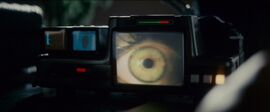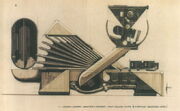| (35 intermediate revisions by 18 users not shown) | |||
| Line 1: | Line 1: | ||
| + | {{VK tab|Film}} |
||
| ⚫ | |||
| + | {{Film Continuity}} |
||
| − | Originating in [[Philip K Dick|Philip K Dick's]] novel ''[[Do Androids Dream of Electric Sheep?]],'' the '''Voight-Kampff machine''' or device (spelled Voigt-Kampff in the book) also appeared in the book's screen adaptation, the 1982 science fiction film [[Blade Runner]]. |
||
| ⚫ | |||
| ⚫ | The '''Voight-Kampff test''' was a test used as of [[2019]] by the [[Los Angeles Police Department|LAPD]]'s [[Blade Runner (police)|Blade Runner]]s to assist in the testing of an individual to see whether they were a [[replicant]] or not. It measured bodily functions such as respiration, heart rate, blushing and eye movement in response to emotionally provocative questions. It typically took twenty to thirty cross-referenced questions to distinguish a [[Nexus-6]] replicant.{{ref|br}} |
||
| + | ==History== |
||
| ⚫ | ''' |
||
| + | In November 2019, the test was conducted by [[Dave Holden]] on the Nexus-6 replicant [[Leon Kowalski]], who suddenly became violent during questioning and shot Holden.{{ref|br}} |
||
| + | Later that month, [[Rick Deckard]] was ordered to perform the test at the [[Tyrell Corporation]] on the [[Nexus-7]],{{ref|br2049}} [[Rachael]]. With her test, it took over one-hundred questions to determine her nature. The reason for this was told to Deckard by [[Eldon Tyrell]], who stated that Rachael was an experimental replicant.{{ref|br}} |
||
| ⚫ | |||
| − | In the film two replicants take the test: [[Leon]] (played by [[Brion James]]) and [[Rachael]] (played by [[Sean Young]]). In ''Blade Runner'', [[Deckard]] tells [[Tyrell]] that it usually takes 20 to 30 cross-referenced questions to distinguish a replicant. With Rachael it takes more than a hundred. Tyrell said Rachael was "special". |
||
| + | Rachael later asked Deckard if he had passed the Voight-Kampff test, but did not receive an answer, as he was asleep.{{ref|br}} |
||
| − | Description from the original 1982 Blade Runner presskit:<br /> |
||
| ⚫ | |||
| ⚫ | |||
| ⚫ | The Voight-Kampff machine is perhaps analogous to (and may have been partly inspired by) [[wikipedia:Alan Turing|Alan Turing]]'s work which propounded an artificial intelligence test — to see if a computer could convince a human (by answering set questions, etc.) that it was another human. The |
||
| + | [[File:VKConcept.jpg|thumb|right|Concept art by [[Syd Mead]]]] |
||
| ⚫ | {{Quote|A very advanced form of lie detector that measures contractions of the iris muscle and the presence of invisible airborne particles emitted from the body. The bellows were designed for the latter function and give the machine the menacing air of a sinister insect. The VK is used primarily by Blade Runners to determine if a suspect is truly human by measuring the degree of his empathic response through carefully worded questions and statements.|''[[Blade Runner]]'' presskit|}} |
||
| + | The test originally appears in [[Philip K. Dick]]'s ''[[Do Androids Dream of Electric Sheep?]]'', where it is spelled "Voigt-Kampff." |
||
| + | |||
| ⚫ | The Voight-Kampff machine is perhaps analogous to (and may have been partly inspired by) [[wikipedia:Alan Turing|Alan Turing]]'s work which propounded an artificial intelligence test — to see if a computer could convince a human (by answering set questions, etc.) that it was another human. The phrase Turing test was popularised by science fiction but was not used until years after Turing's death. |
||
| + | |||
| + | The eye footage seen on the machine's screen was stock footage secured from [[wikipedia:Oxford Scientific Films|Oxford Scientific]]. Some actors, such as [[Brion James]], had their own eyes filmed, but for budgetary reasons, it was decided to use only stock footage.{{ref|fn}} |
||
| + | |||
| + | ==See also== |
||
| + | *[[Baseline Test]] |
||
==References== |
==References== |
||
| + | {{Reflist}} |
||
| − | *''Future Noir: The Making of Blade Runner'' by Paul Sammon (Orion, 2004) ISBN 0752807404 |
||
| − | *''Retrofitting Blade Runner: Issues in Ridley Scott's "Blade Runner" and Philip K. Dick's "Do Android's Dream of Electric Sheep?" '' by Judith Kerman (Popular Press, 2003) ISBN 0879725109 |
||
==External links== |
==External links== |
||
| Line 21: | Line 31: | ||
{{Blade Runner}} |
{{Blade Runner}} |
||
| + | [[ja:フォークト=カンプフ検査]] |
||
| − | [[Category: |
+ | [[Category:Culture]] |
| + | [[Category:Film continuity]] |
||
Revision as of 01:40, 6 July 2020
|
| |||||

The Voight-Kampff test was a test used as of 2019 by the LAPD's Blade Runners to assist in the testing of an individual to see whether they were a replicant or not. It measured bodily functions such as respiration, heart rate, blushing and eye movement in response to emotionally provocative questions. It typically took twenty to thirty cross-referenced questions to distinguish a Nexus-6 replicant.[1]
History
In November 2019, the test was conducted by Dave Holden on the Nexus-6 replicant Leon Kowalski, who suddenly became violent during questioning and shot Holden.[1]
Later that month, Rick Deckard was ordered to perform the test at the Tyrell Corporation on the Nexus-7,[2] Rachael. With her test, it took over one-hundred questions to determine her nature. The reason for this was told to Deckard by Eldon Tyrell, who stated that Rachael was an experimental replicant.[1]
Rachael later asked Deckard if he had passed the Voight-Kampff test, but did not receive an answer, as he was asleep.[1]
Behind the scenes

Concept art by Syd Mead
"A very advanced form of lie detector that measures contractions of the iris muscle and the presence of invisible airborne particles emitted from the body. The bellows were designed for the latter function and give the machine the menacing air of a sinister insect. The VK is used primarily by Blade Runners to determine if a suspect is truly human by measuring the degree of his empathic response through carefully worded questions and statements."―Blade Runner presskit
The test originally appears in Philip K. Dick's Do Androids Dream of Electric Sheep?, where it is spelled "Voigt-Kampff."
The Voight-Kampff machine is perhaps analogous to (and may have been partly inspired by) Alan Turing's work which propounded an artificial intelligence test — to see if a computer could convince a human (by answering set questions, etc.) that it was another human. The phrase Turing test was popularised by science fiction but was not used until years after Turing's death.
The eye footage seen on the machine's screen was stock footage secured from Oxford Scientific. Some actors, such as Brion James, had their own eyes filmed, but for budgetary reasons, it was decided to use only stock footage.[3]
See also
References
- ↑ 1.0 1.1 1.2 1.3 Blade Runner – all versions
- ↑ Blade Runner 2049
- ↑ Future Noir: The Making of Blade Runner – Revised & Updated Edition
External links
- Voight-Kampff entry - Official Blade Runner online magazine
- Excerpt describing the machine from "Do Androids Dream of Electric Sheep?"
| |||||||||||||||||||||||||||||||||||||||||
